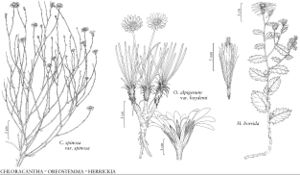Herrickia
Contr. U.S. Natl. Herb. 16: 186, plate 50. 1913.
| Taxon | Illustrator ⠉ | |
|---|---|---|
 | Chloracantha spinosa var. spinosa Oreostemma alpigenum var. haydenii Herrickia horrida | Linny Heagy Barbara Alongi Yevonn Wilson-Ramsey |
Perennials or subshrubs, 1–70 cm (rhizomes elongate and slender to short and thick, often becoming woody, or woody caudices). Stems ascending to erect, usually simple, rarely branched proximally, glabrous or thinly scabridulous, sometimes stipitate-glandular (mostly distally). Leaves mostly basal or mostly cauline; alternate; sessile or petiolate; blades 1-nerved, oblanceolate to spatulate, distal usually gradually reduced, margins entire or spinulose-serrate, faces glabrous or scabrellous, sometimes stipitate-glandular. Heads radiate, in corymbiform arrays or borne singly. Involucres cylindro to hemispherico-campanulate, (6–12 ×) 5–10 mm. Phyllaries 15–40+ in 3–6 series, 1-nerved (low-keeled or rounded adaxially), spatulate, oblanceolate, oblong-obovate, oblong, ovate, lanceolate, or linear-lanceolate, unequal, bases indurate, margins narrowly scarious (sometimes foliaceous), often ciliolate; green zones ± basally truncate, usually in distal 1/5–9/10, rarely wholly foliaceous (outer) to less than 1/6 and only along midveins (inner); (apices acute to long-acuminate), faces glabrous, usually stipitate-glandular. Receptacles flat to slightly convex, pitted, epaleate. Ray-florets 8–27, pistillate, fertile; corollas white to purple (coiling at maturity). Disc-florets 12–43, bisexual, fertile; corollas yellow, becoming purple at maturity, barely ampliate, tubes shorter to longer than funnelform to campanulate throats, lobes 5, erect to spreading, triangular or lanceolate; style-branch appendages lanceolate. Cypselae cylindro-obconic to fusiform, ± compressed, 7–10-nerved, faces glabrous or densely strigillose, eglandular; pappi persistent, of 35–70+, yellowish to cinnamon or tawny, unequal, ± stiff, barbellate, apically attenuate or (longer) sometimes ± clavate bristles in 1+ series. x = 9.
Distribution
w United States
Discussion
Species 4 (4 in the flora).
G. L. Nesom (1994b) included Herrickia within Eurybia, as sect. Herrickia in subg. Eurybia, adding E. glauca and E. wasatchensis to the section. L. Brouillet et al. (2004) added H. kingii to the group and confirmed the membership proposed by Nesom using molecular phylogenetic data. Previously, Nesom (1991e) had placed H. kingii in Tonestus, a polyphyletic group. In the eurybioids, a grade basal to subtribe Machaerantherinae, the order of appearance of the genera recognized here is: Oreostemma, Herrickia, Eurybia, and Triniteurybia. This underscores the intermediate position of the eurybioids between basal x = 9, asterlike, more or less mesic ancestors, and the more xeric and derived Machaerantherinae.
Selected References
None.
Key
| 1 | Leaves basal and cauline; plants taprooted or with caudices; rays white to pale lavender | Herrickia kingii |
| 1 | Leaves mostly cauline; plants rhizomatous; rays purple | > 2 |
| 2 | Phyllaries appressed | Herrickia glauca |
| 2 | Phyllaries squarrose or spreading | > 3 |
| 3 | Perennials; leaves ± clasping, entire, eglandular | Herrickia wasatchensis |
| 3 | Subshrubs; leaves cordate-clasping, spinulose-serrate, glandular | Herrickia horrida |
"[" is not declared as a valid unit of measurement for this property."]" is not declared as a valid unit of measurement for this property.